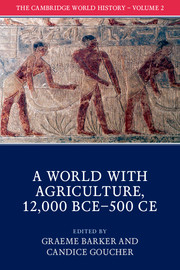Crossref Citations
This Book has been
cited by the following publications. This list is generated based on data provided by Crossref.
Lazaridis, Iosif
Nadel, Dani
Rollefson, Gary
Merrett, Deborah C.
Rohland, Nadin
Mallick, Swapan
Fernandes, Daniel
Novak, Mario
Gamarra, Beatriz
Sirak, Kendra
Connell, Sarah
Stewardson, Kristin
Harney, Eadaoin
Fu, Qiaomei
Gonzalez-Fortes, Gloria
Jones, Eppie R.
Roodenberg, Songül Alpaslan
Lengyel, György
Bocquentin, Fanny
Gasparian, Boris
Monge, Janet M.
Gregg, Michael
Eshed, Vered
Mizrahi, Ahuva-Sivan
Meiklejohn, Christopher
Gerritsen, Fokke
Bejenaru, Luminita
Blüher, Matthias
Campbell, Archie
Cavalleri, Gianpiero
Comas, David
Froguel, Philippe
Gilbert, Edmund
Kerr, Shona M.
Kovacs, Peter
Krause, Johannes
McGettigan, Darren
Merrigan, Michael
Merriwether, D. Andrew
O'Reilly, Seamus
Richards, Martin B.
Semino, Ornella
Shamoon-Pour, Michel
Stefanescu, Gheorghe
Stumvoll, Michael
Tönjes, Anke
Torroni, Antonio
Wilson, James F.
Yengo, Loic
Hovhannisyan, Nelli A.
Patterson, Nick
Pinhasi, Ron
and
Reich, David
2016.
Genomic insights into the origin of farming in the ancient Near East.
Nature,
Vol. 536,
Issue. 7617,
p.
419.
Williams, Adrian C
and
Hill, Lisa J
2019.
Nicotinamide as Independent Variable for Intelligence, Fertility, and Health: Origin of Human Creative Explosions?.
International Journal of Tryptophan Research,
Vol. 12,
Issue. ,
Bookman, Revital
2020.
Large Asian Lakes in a Changing World.
p.
1.
Li, Haiming
Liu, Zhen
James, Nathaniel
Li, Xinsheng
Hu, Zhujun
Shi, Hongwei
Sun, Liqiang
Lu, Yong
and
Jia, Xin
2021.
Agricultural Transformations and Their Influential Factors Revealed by Archaeobotanical Evidence in Holocene Jiangsu Province, Eastern China.
Frontiers in Earth Science,
Vol. 9,
Issue. ,
Ikeya, Kazunobu
2021.
Ethnoarchaeology of Introducing Agriculture and Social Continuity among Sedentarised Hunter–Gatherers: The Transition from the Jomon to the Yayoi Period.
Quaternary,
Vol. 4,
Issue. 3,
p.
28.
Sahakyan, Hovhannes
Margaryan, Ashot
Saag, Lauri
Karmin, Monika
Flores, Rodrigo
Haber, Marc
Kushniarevich, Alena
Khachatryan, Zaruhi
Bahmanimehr, Ardeshir
Parik, Jüri
Karafet, Tatiana
Yunusbayev, Bayazit
Reisberg, Tuuli
Solnik, Anu
Metspalu, Ene
Hovhannisyan, Anahit
Khusnutdinova, Elza K.
Behar, Doron M.
Metspalu, Mait
Yepiskoposyan, Levon
Rootsi, Siiri
and
Villems, Richard
2021.
Origin and diffusion of human Y chromosome haplogroup J1-M267.
Scientific Reports,
Vol. 11,
Issue. 1,
Godinho, Ricardo Miguel
Umbelino, Cláudia
Valera, António Carlos
Carvalho, António Faustino
Bicho, Nuno
Cascalheira, João
Gonçalves, Célia
and
Smith, Patricia
2023.
Mandibular morphology and the Mesolithic–Neolithic transition in Westernmost Iberia.
Scientific Reports,
Vol. 13,
Issue. 1,
Moubtahij, Zineb
McCormack, Jeremy
Bourgon, Nicolas
Trost, Manuel
Sinet-Mathiot, Virginie
Fuller, Benjamin T.
Smith, Geoff M.
Temming, Heiko
Steinbrenner, Sven
Hublin, Jean-Jacques
Bouzouggar, Abdeljalil
Turner, Elaine
and
Jaouen, Klervia
2024.
Isotopic evidence of high reliance on plant food among Later Stone Age hunter-gatherers at Taforalt, Morocco.
Nature Ecology & Evolution,
Vol. 8,
Issue. 5,
p.
1035.
Bouafou, Lemonde
Makanga, Boris K.
Rahola, Nil
Boddé, Marilou
Ngangué, Marc F.
Daron, Josquin
Berger, Audric
Mouillaud, Theo
Makunin, Alex
Korlević, Petra
Nwezeobi, Joachim
Kengne, Pierre
Paupy, Christophe
Lawniczak, Mara K. N.
and
Ayala, Diego
2024.
Host preference patterns in domestic and wild settings: Insights into Anopheles feeding behavior.
Evolutionary Applications,
Vol. 17,
Issue. 6,



